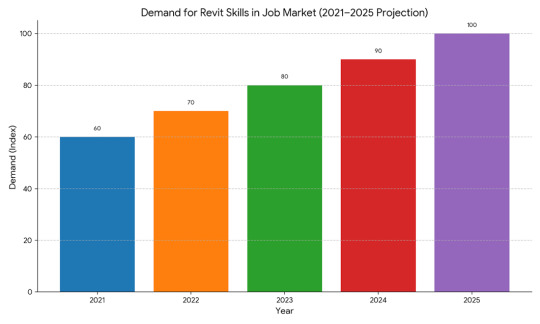#Revit archtecture
Explore tagged Tumblr posts
Text
Revit Architecture Courses That Shape Future-Ready Designers
In the age of smart buildings and digital blueprints, mastering Revit Architecture can be a game-changer for architects, civil engineers, and design professionals. With its powerful modeling tools, real-time collaboration features, and data-driven workflows, Revit has become the industry standard for Building Information Modeling (BIM). If you're seeking to stay ahead in the design world, Revit Architecture courses are your stepping stone.
Why Revit Architecture Matters in 2025:
Traditional drafting methods are fading fast. Today’s construction and design projects demand more precision, speed, and coordination. Revit Architecture enables:
Parametric modeling that adjusts instantly with design changes
Multi-disciplinary collaboration across architecture, MEP, and structural design
3D visualization and rendering that help clients see the full picture
Accurate documentation that reduces rework and onsite errors
What to Expect from a Revit Course:
A well-structured course helps learners move from basics to expert-level functionalities. Here's what most top-tier courses cover:
1. Introduction to BIM and Revit Interface
Understanding BIM methodology
Navigating through Revit workspace
2. Modeling Essentials
Walls, floors, roofs, and ceilings
Doors, windows, and components
3. Advanced Tools
Families and parametric components
Phasing and design options
Worksharing and team collaboration
4. Documentation and Visualization
Creating sheets, schedules, and legends
Rendering and walkthrough creation
5. Real-World Project Integration
Applying concepts on residential, commercial, and infrastructure projects
Interdisciplinary coordination using shared models
Who Should Enroll?
Revit courses are ideal for:
Architecture students and graduates
Civil and structural engineers
Interior designers
Construction professionals seeking digital upgrades
Benefits of Learning Revit Course:
Higher employability: Firms actively seek professionals with BIM knowledge
Better productivity: Save time by automating routine tasks and cutting down on human errors during the design process.
Better design presentation: Showcase ideas with interactive 3D models and walkthroughs
Future-proof skill: As smart construction grows, BIM becomes indispensable
Case Studies:
Case Study 1: From Sketches to Smart Buildings
Background: Riya, an architecture student in Pune, enrolled in a 3-month Revit course alongside her college curriculum. Challenge: Her internship project required creating detailed 3D models and producing accurate drawings. Outcome: Using Revit, she modeled a duplex residence with precision and was offered a full-time job post-internship.
Case Study 2: Engineering Precision at Scale
Background: An MNC in Bangalore adopted Revit to streamline its structural and architectural workflows. Challenge: Frequent clashes and delays due to siloed teams using different tools. Outcome: After enrolling their team in a certified Revit training, they completed a commercial project 20% faster, reducing errors and enhancing collaboration.
Case Study 3: Freelancer to BIM Consultant
Background: Arjun, a freelance draftsman, relied heavily on AutoCAD. Challenge: Losing projects to BIM-certified professionals. Outcome: Post completion of an advanced Revit course, he transitioned to a BIM consultant and secured international contracts through online platforms.
Conclusion:
The design world is changing fast—and Revit is helping lead the way. Learning Revit Architecture isn’t just about using a new tool; it’s about gaining a smart skill that helps you design better, faster, and with more creativity. Whether you’re a student, a working professional, or part of a company, Revit can support your growth in 2025 and beyond.
As Revit keeps getting better, it makes planning and building easier and more accurate. By learning it now, you’ll be ready for the future—and stand out in the world of architecture and design.

0 notes
Photo

ARCHTECTURE GROUND FLOOR PLAN
Our company CLIK CAD DRAFTING complete this project ground floor plan detailing.
Our architectural engineering CAD services include plan is architectural 2D floor plan view.
Plan exterior detailing, interior design walkthrough / flythrough services
And architectural animation services.
# Architect ground floor Plan
Company: CLIK CAD DRAFTING
Visit: http://www.caddraftingservices.in
Get a free instant quote [email protected]
0 notes
Text
Revit Architecture Courses That Shape Future-Ready Designers
In the world of modern architecture and construction, digital design tools are changing how buildings come to life. Among these, Autodesk Revit Architecture stands out as a powerful BIM (Building Information Modeling) software used by architects, engineers, and designers globally. If you’re looking to build a strong career in architecture or construction design, enrolling in a Revit Architecture course could be your best move.
What is Revit Architecture?
Revit Architecture is a building design software from Autodesk that allows professionals to create precise plans, 3D models, and visualizations of building projects. It’s more than just CAD—it’s BIM-based, which means your designs are linked to real-world data and workflows.
Why Learn Revit Architecture?
Industry-standard tool in architecture firms
Faster, accurate modeling & documentation
Real-time collaboration with teams
Improves productivity & reduces errors
Enhances employability in AEC industry
Core Topics Covered in Revit Architecture Courses:
A quality Revit course will cover:
Revit Interface & Navigation
Building Modeling (Walls, Floors, Roofs, Doors)
3D Views and Rendering
Families and Components
Annotations and Documentation
Worksharing and Collaboration Tools
Construction Phasing
Energy Analysis (Optional – Advanced Level)
Who Should Enroll in Revit Architecture Courses?
This course is ideal for:
Architecture Students
Civil Engineers
Interior Designers
BIM Coordinators
Working professionals in AEC industry
Anyone switching from AutoCAD to Revit
Benefits of Revit Certification:
Adds value to your CV
Improves your hiring potential
Shows proof of technical proficiency
Recognized globally
Builds confidence in delivering BIM projects
Bar Graph: Demand for Revit Skills in Job Market (2021–2025 Projection)


Top Career Opportunities After Learning Revit Architecture:
Once you complete a Revit Architecture course, a wide range of job roles become accessible. Professionals with Revit expertise are in high demand in both the design and construction sectors. Here are some great job options you can go for after learning Revit:
BIM Modeler – Focus on developing intelligent 3D models that support construction planning and facility management across large infrastructure projects.
Revit Specialist – Play a key role in producing, editing, and managing Revit-based architectural and structural models for precision-driven designs.
Architectural Planner – Use Revit to create comprehensive layouts, concept designs, and detailed drawings that align with modern architectural practices.
BIM Project Coordinator – Oversee the collaboration between architectural, structural, and MEP teams, ensuring all design data is aligned throughout the project lifecycle.
3D Visualization Expert – Bring designs to life through photorealistic renderings and walkthroughs that help clients understand and approve concepts quickly.
Conclusion:
Revit Architecture is not just a tool—it’s a career booster. Whether you're a student stepping into the architecture world or a professional aiming to upskill, learning Revit can open doors to new and better job opportunities. With the construction industry moving toward digital transformation, being Revit-ready is a smart, future-proof choice.
FAQs:
Q1. How long does it take to learn Revit Architecture? A beginner course typically takes 1 to 2 months depending on your pace.
Q2. Is Revit better than AutoCAD? For BIM-based architectural design, Revit is more efficient and advanced than AutoCAD.
Q3. Do I need a background in architecture to learn Revit? Not necessarily. Anyone interested in building design and modeling can learn Revit with the right guidance.
Q4. Can I learn Revit online? Yes, many online platforms offer Revit courses with live projects and certifications.
0 notes